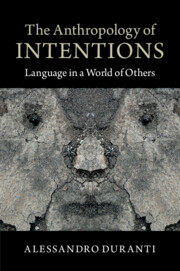Book contents
- Frontmatter
- Contents
- List of figures
- Acknowledgments
- 1 Rethinking anti-intentionalism
- 2 Intentions in speaking and acting: the Standard Theory and its foes
- 3 The avoidance of intentional discourse: a Samoan case study
- 4 The invention of promising in the Samoan translation of the Bible
- 5 Intentionality and truth, revisited
- 6 Speaker intentions and the role of the audience in a political campaign in the US
- 7 A dialogue on intentions
- 8 Opacity of other minds: local theories revisited
- 9 Intentions and their modifications: a lesson from Husserl
- 10 A sense of the other: from intentionality to intersubjectivity
- 11 The intentional continuum
- Appendix A Transcription conventions for English examples
- Appendix B Transcription conventions and abbreviations used in the Samoan examples
- Notes
- References
- Index
7 - A dialogue on intentions
Published online by Cambridge University Press: 18 December 2014
- Frontmatter
- Contents
- List of figures
- Acknowledgments
- 1 Rethinking anti-intentionalism
- 2 Intentions in speaking and acting: the Standard Theory and its foes
- 3 The avoidance of intentional discourse: a Samoan case study
- 4 The invention of promising in the Samoan translation of the Bible
- 5 Intentionality and truth, revisited
- 6 Speaker intentions and the role of the audience in a political campaign in the US
- 7 A dialogue on intentions
- 8 Opacity of other minds: local theories revisited
- 9 Intentions and their modifications: a lesson from Husserl
- 10 A sense of the other: from intentionality to intersubjectivity
- 11 The intentional continuum
- Appendix A Transcription conventions for English examples
- Appendix B Transcription conventions and abbreviations used in the Samoan examples
- Notes
- References
- Index
Summary
Introduction
This chapter reproduces a continuous series of fairly long email messages initiated by discourse analyst and cognitive scientist Teun van Dijk, who wrote to me on November 1, 2004 to ask me “a theoretical question,” as he put it, about my position on the role of intentions in discourse. A number of factors, including electronic mail as a medium for unedited and informal exchanges as well as the long-term professional relationship between the two of us (over several decades van Dijk has involved me in a number of his editorial projects), made possible what I hope readers will appreciate as a frank exchange of ideas and positions that is rarely found in the more polished and peer-reviewed journal articles or chapters of edited volumes. I have also included toward the end of this chapter a message by my colleague Jason Throop, whom I invited to join the discussion. His response to the exchanges I had forwarded to him captures his own original ways of thinking about intentions and anticipates some of the themes found in the following chapters, themes that since 2010 have been incorporated into our jointly taught seminar on the culture of intersubjectivity at UCLA.
In reproducing this exchange of emails as a chapter of this book, I have resisted the urge to provide here a summary of the entire discussion for the simple reason that almost each message contains some attempt to clarify both the points of agreement and those of disagreement. I believe that any additional, post hoc summary of mine could not do justice to the friendly tension of the arguments whose main value is both the genuineness of the claims contained in it. Hence, with minimal cuts (of greetings at the beginning and the end of each message) and a few added references, here is what we wrote to each other over a few days, in the fall of 2004.
- Type
- Chapter
- Information
- The Anthropology of IntentionsLanguage in a World of Others, pp. 151 - 174Publisher: Cambridge University PressPrint publication year: 2015

